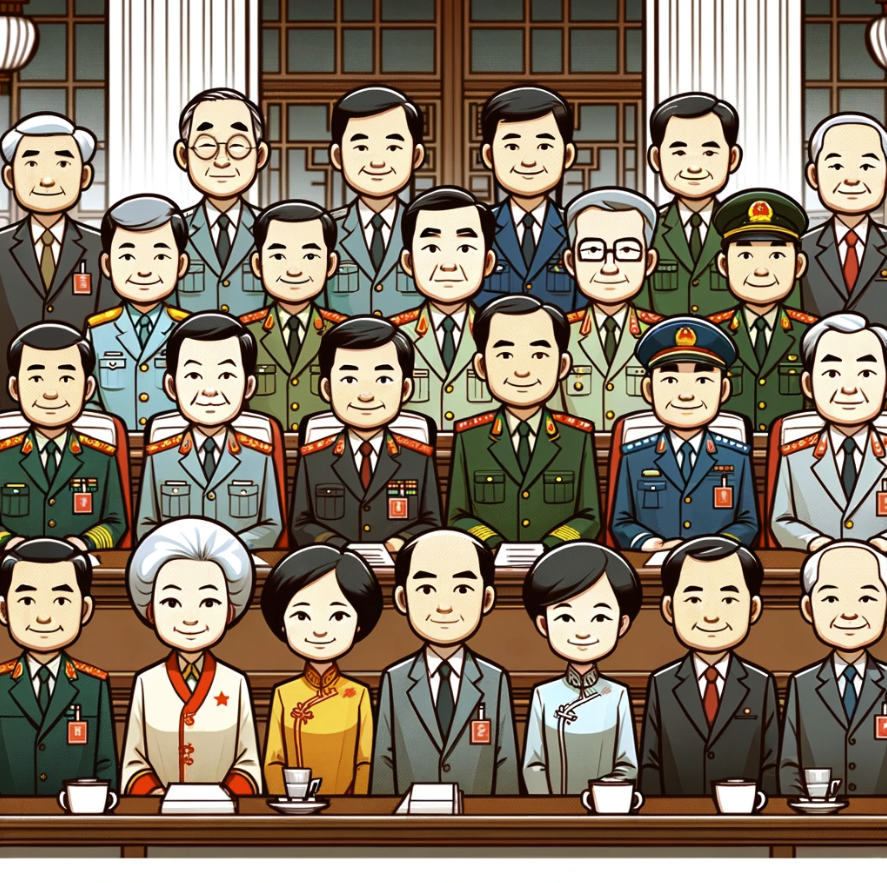Let’s look at the structure of the Chinese government:
National Congress
The National Congress of the Chinese Communist Party (CCP) serves as the party’s highest body.
Held every five years, it is responsible for setting major policies and electing the Central Committee.
Delegates from across China attend the Congress, representing a wide range of party members.
During these sessions, key policy directions are formulated, and leadership transitions are often signaled.
Central Committee
Elected by the National Congress, the Central Committee is a powerful political body in the CCP.
It comprises about 200 full members and a similar number of alternate members.
This committee meets at least once a year in a plenary session to discuss and decide on major policy issues.
Between plenums, its work is carried out by the Politburo and its Standing Committee.
The Central Committee is instrumental in shaping national policies and has significant influence over the country’s direction.
Politburo
The Politburo, or Political Bureau, consists of the top leaders of the CCP.
Its membership (usually around 25 members) is drawn from the Central Committee.
The Politburo is a crucial decision-making body, overseeing the implementation of policies set by the National Congress and the Central Committee.
It meets regularly to discuss and decide on key issues pertaining to national governance, economic development, foreign policy, and more.
Politburo Standing Committee
At the apex of the CCP’s power structure is the Politburo Standing Committee.
Comprising the top leadership of the party, usually 5 to 9 members, it is the most influential political entity in China.
The members of this elite group are typically the heads of major party and state organs.
The Standing Committee makes decisions on the most critical issues facing the country.
Its deliberations and decisions guide China’s domestic and foreign policies, shaping the nation’s future.
In summary, the Chinese government’s power structure is hierarchical and centralized, with each level playing a distinct role in policy-making and governance.
The National Congress sets the overarching direction, the Central Committee shapes and approves policies, the Politburo implements these policies, and the Politburo Standing Committee oversees and directs the most crucial aspects of governance.
This structure ensures centralized control and coordination in the governance of China.
Additional Structures
The structure of the Chinese government and the Chinese Communist Party (CCP) also involves several other key components that contribute to the overall governance and administration of the country.
These include:
State Council
The State Council, or the Central People’s Government, acts as China’s chief administrative authority.
It is responsible for implementing the policies and regulations set forth by the CCP and managing the day-to-day administrative affairs of the country.
The State Council includes the Premier, Vice Premiers, State Councilors, Ministers of various ministries, and the Governor of the People’s Bank of China.
It plays a vital role in economic management, social development, and the coordination of domestic and foreign affairs.
National People’s Congress
The National People’s Congress (NPC) is China’s highest organ of state power.
It functions as the legislative body of the People’s Republic of China.
The NPC passes laws, elects and supervises high-level government officials, and has the power to amend the constitution.
The NPC and its Standing Committee also have the authority to interpret laws and make decisions on major national issues.
Discipline Inspection Commissions
Discipline Inspection Commissions, operating at various levels of the party hierarchy, play a critical role in maintaining internal discipline within the CCP.
They are responsible for enforcing party discipline, combating corruption, and ensuring compliance with party rules and regulations.
The Central Commission for Discipline Inspection is the highest body overseeing these matters and plays a key role in the party’s anti-corruption efforts.
Local Government and Party Organizations
Local governments and CCP organizations at the provincial, city, and county levels form an integral part of China’s governance structure.
These local entities are responsible for implementing national policies, managing regional affairs, and ensuring that the directives of the central government are carried out effectively in their respective jurisdictions.
Military Leadership
The People’s Liberation Army (PLA) is under the dual leadership of the CCP and the Central Military Commission (CMC).
The CMC, chaired by the CCP General Secretary, is responsible for the overall administration and command of the armed forces.
The PLA’s integration into the party-state structure ensures that the military remains under the firm control of the CCP.
Conclusion
China’s governance structure is characterized by a complex interplay between the party and state institutions.
While the CCP remains the central authority guiding policy and decision-making, various state organs and local governments play significant roles in the country’s administration and governance.
This structure reflects the party’s emphasis on centralized control and top-down governance, ensuring coherence in policy implementation across the vast nation.


